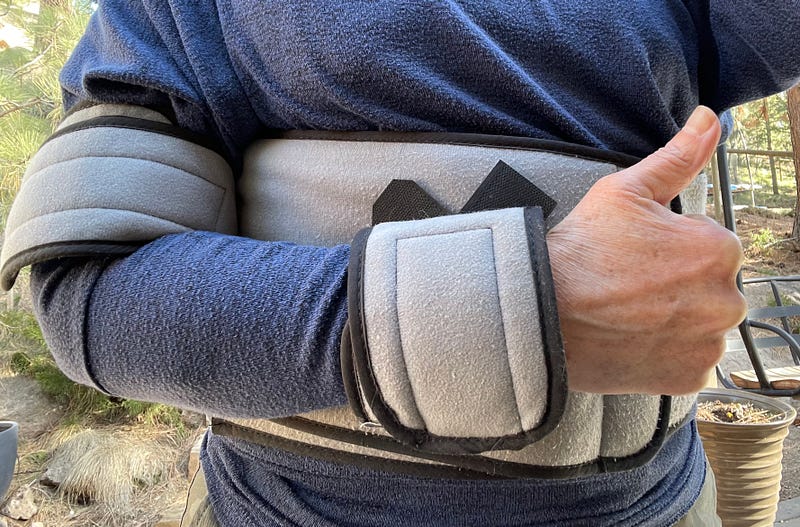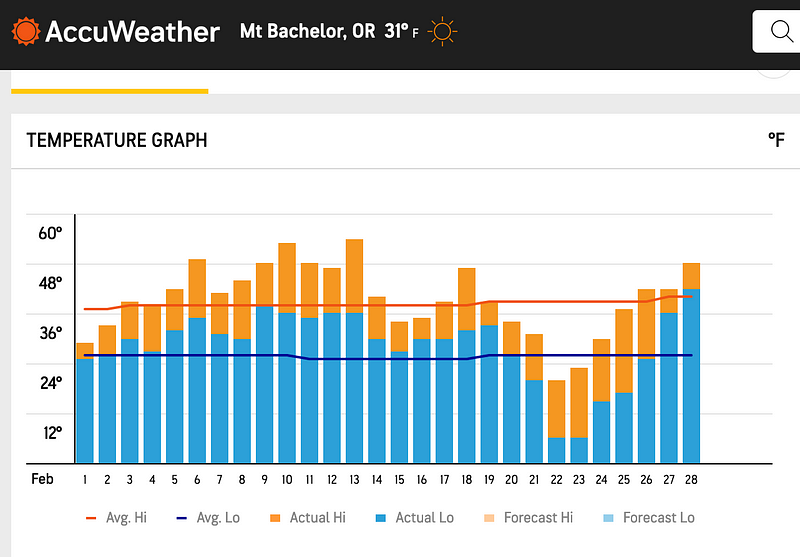Skiing, Climate Change, and a Broken Arm: A Cautionary Tale
Written on
Chapter 1: A Day at Mt. Bachelor
On February 27th, my sister and I decided to take advantage of a stunning day at Mt. Bachelor, our local ski area. After a few enjoyable runs on freshly groomed trails, we opted to hike up to a spot called the Pinnacles. From this vantage point, skiers often drop into a bowl that is renowned for providing some of the best conditions on the mountain. While it may sound challenging, I assure you it's quite manageable for intermediate skiers—certainly not in the same league as some extreme terrains.
However, when we peered down into the bowl from our lofty perch, what appeared to be a welcoming expanse of snow was actually an icy surface disguised under a light dusting of new snow, littered with frozen chunks and uneven crusts. Instead of risking a descent down the bowl, we decided to traverse to the opposite side, which seemed less treacherous. My sister successfully navigated the traverse, while I found myself stuck on an ice formation known as a "chicken head."

No, not the poultry kind! In skiing terminology, a chicken head refers to an ice chunk that appears harmless but is, in fact, firmly anchored to the ice beneath. Instead of rolling away when nudged, it can cause serious falls.
I’ll spare you the details, but this incident marked the first time in my 40 years of skiing that I required assistance from ski patrol, who were nothing short of heroes that day. A visit to urgent care confirmed I had broken a piece of my humerus, leading to six weeks of wearing a rather sophisticated immobilizing sling.

So, what does this experience have to do with climate change? Sure, I could use some improvement in my skiing skills, but the thaw-freeze cycle this year has intensified hazards like chicken heads and icy patches.
Section 1.1: Weather vs. Climate
Having skied at Mt. Bachelor for 18 winters, I’ve witnessed the unpredictable weather on this volcanic mountain—everything from whiteouts and gale-force winds to snow that resembles mashed potatoes. Chicken heads have always been part of the skiing landscape here. However, let's examine the weather data.

When temperatures remain consistently low, the snow stays light and fluffy. Conversely, warm spells transform powder into heavy slush. Throughout February, temperatures often exceeded freezing and were significantly above historical averages, leading to soft, mushy snow during the day, followed by a hard freeze at night. This cycle continued until the cold snap on the 22nd and 23rd, which resulted in a treacherous surface of ice chunks and chicken heads.
Weather can be managed—just dress in layers, pack a goggle scraper, and take a break for hot cocoa. Climate, however, is different. Climate change is gradual, akin to a slow-moving barge; its effects may be subtle at first, but eventually, you find yourself facing a dramatically altered reality.
I shared my theory about climate change and my injury with a friend, who, albeit gently, implied that I was simply unlucky and that warm weather in February is a natural cycle. While she had a point, the data shows that only a third of the days reached the average low, while two-thirds were significantly warmer than usual. Recent studies in Oregon confirm that hot days are increasing, along with overall daily highs. Is it merely weather, or is it indicative of a larger climate trend?
Section 1.2: The Impact of Climate Change on Ski Resorts
My story is just one example of how climate change is affecting winter sports. Ski resorts from Aspen to the French Alps face threats from diminished snowfall, drought, and rising temperatures. Organizations like Protect Our Winters (POW) are actively working to combat climate change through advocacy, policy changes, and innovative technologies.
Ski resorts, including Mt. Bachelor, contribute to rising carbon emissions and must find ways to mitigate their impact. Mt. Bachelor has initiated a Play Forever environmental stewardship program aimed at reducing its carbon footprint. However, this initiative often flies under the radar, as many of us, myself included, have been too busy enjoying sunny ski days to focus on emissions.
As I ponder my role in climate change, I recognize several actions I can take for next season: carpooling, using public transport, lowering my home thermostat while away, and supporting ski resorts that prioritize sustainability. Though these efforts may seem small, collective actions can lead to meaningful change.
Chapter 2: Moving Forward
The first video titled "Climate Denial: A Measured Response" explores the various responses to climate change and the importance of informed dialogue.
The second video, "Climate Change is Breaking Us – Here's How to Cope," discusses coping mechanisms and strategies to adapt to the realities of climate change.